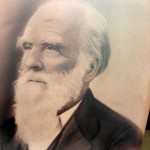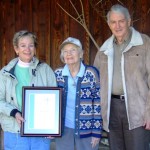Washington County’s Internationally Famous Botanist
Ignorance is such a terrible, stubborn, throat-cutting thing.
Gideon Lincecum
Born in Georgia in 1793, Gideon Lincecum grew up playing with and being educated by the Muscogee Indians. He developed a sharp curiosity and keen understanding of the natural environment, despite only five months of formal schooling. As a child, his family often moved from place to place, causing him to become self-reliant and resourceful. At the age 15, he struck out on his own, and continued to explore new territories. Gideon participated in the War of 1812.
Married at age 21, Gideon and his young bride settled in Columbus, Mississippi, where he had intimate contact with Native Americans, living with and trading with the Choctaw, Chickasaw, and Cherokee tribes. Gideon learned to speak and write the language of the local Choctaw nation. This knowledge set him apart from other settlers, allowing him a deeper understanding of Native American ways and beliefs.
In 1835, Gideon joined a group of Mississippians to explore Texas to determine if conditions there were favorable for emigration. This excursion made a lasting impression on Gideon, providing ample opportunities to study and record the vast wonders of Texas. After two months of exploring the Trinity, San Jacinto, Brazos and Colorado River valleys, Gideon’s companions headed home leaving him to continue to explore the wilderness, living off nature’s bounty.
Along the way, Gideon spotted a league of land on a long point of high ground in Washington County near Yegua Creek, an ideal place to settle. Unable to afford the $5 purchase price, he marked the property to reserve it for the future. Thirteen years later, he returned, purchased the land for 75 cents per acre and named it Long Point.
It was at Long Point that Gideon’s interest in natural science flourished. This self-taught naturalist spent countless hours observing birds, insects, weather, rocks, and plants. He regularly corresponded with like-minded individuals, including Charles Darwin, and published numerous articles in scholarly scientific journals. Even though he lacked the credentials of a formal education, Gideon came to be recognized as a thorough and respected researcher; in particular, his in-depth studies of ants in Texas were internationally renowned.
When he was 80 years old, Gideon began writing a detailed autobiography largely devoted to his frontier hunting and fishing adventures. This was published in 19 weekly issues of the “American Sportsman” from September 1874 to January 1875. He died in November 1874.
Despite his controversial ways and beliefs, those who knew Gideon Lincecum regarded him as a man of honor, dedicated to the betterment of society through exploration and research. His never-ending curiosity served him well and led to his notable resting place at the Texas State Cemetery where he was interred in 1936.
Sources:
Anne McGaugh, Former Education Curator, Star of Texas Museum
Lois Wood Burkhalter, Handbook of Texas Online, Texas State Historical Association
The Gideon Lincecum Virtual Herbarium
The Gideon Lincecum Virtual Herbarium presents the historical background and content of the Gideon Lincecum herbarium of early Texas and Mississippi medicinal plants, housed in the Gideon Lincecum Collection, 1821-1933, Dolph Briscoe Center for American History, The University of Texas at Austin.
Historic Lincecum Cabin
The cabin where Gideon Lincecum did most of his work was restored and moved from the site of his former home in Long Point to private property nearby. For many years, Elinor Jacobs welcomed Master Naturalists to her home to visit the restored cabin. Elinor was always gracious and entertaining with her stories about our chapter’s namesake.
In 2009, chapter members Monterey White and Dave Redden presented Elinor with a token of our gratitude for her hospitality. She received a certificate of membership for the Gideon Lincecum chapter along with a Texas Master Naturalist dragonfly pin.





